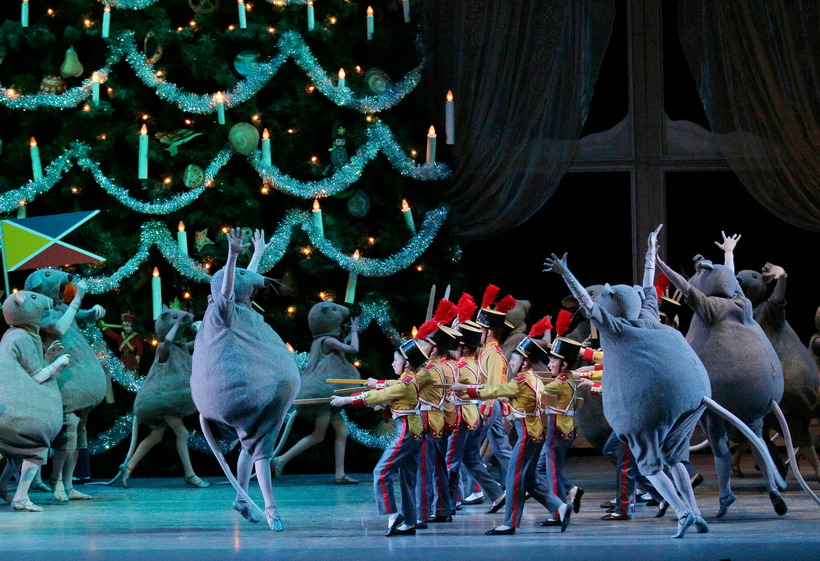One night in late November, I was lying in bed thinking about this December column. I wanted to write about the absence of The Nutcracker this year, cancelled due to the coronavirus. The Bolshoi, the Mariinsky, and the Royal Ballet do plan to present live Nutcrackers; most other companies, however, will offer the ballet online. It’s a huge blow to their budgets—income from The Nutcracker keeps companies afloat. As for the audience, the ballet is variously a tradition, a treat, a Christmas spectacle, an aesthetic ritual. While I was wondering what the holidays would be like without the ballet, I heard our cat Esmé in the living room, a scrambling dash and thump. Then silence. Then another dash and thump. This was not the usual rhythm of her nocturnal play. I went out to find—EEEEEEEK—a mouse. It was wriggling in her mouth. The Nutcracker was happening in my home.
You may recall that this ballet, created in 1892 by Marius Petipa, Lev Ivanov, and Pyotr Ilyich Tchaikovsky, is based on Alexandre Dumas’s retelling of an 1816 story by E. T. A. Hoffmann, “Nutcracker and Mouse King.” It’s a strange dream tale that juggles psychology, reality, and fantasy. In the book and in the ballet, it is the appearance of mice that signals the beginning of young Marie’s dream. Hoffmann writes, “Now a wild giggling and whistling started all around and virtually a thousand little feet were trotting and scurrying behind the walls and virtually a thousand little candle stubs were flickering through the cracks in the floorboards. Still these weren’t candle stubs, no! These were tiny, sparkling eyes. And Marie realized that mice were peering out and preparing themselves everywhere.”
As I wrote in last year’s December Letter, The Nutcracker is not child’s play. The cozy formality of the Christmas party that fills the first half of Act One gives way to a dream that is cold and bright, feral and surreal. The dream moves through a battle between toy soldiers and those scurrying mice, then into a primeval forest, snow-blanketed, to finally arrive in Act Two’s Land of Sweets.

The closest we can come to the original Mariinsky production of 1892, and fidelity to Petipa’s scenario as borne in Tchaikovsky’s music, is George Balanchine’s production of 1954, made for the New York City Ballet when the company was six years old. In his youth, on the Mariinsky stage, Balanchine danced the roles of mouse, the Nutcracker/Little Prince, and the Mouse King; later he danced Candy Cane. When it came to his own Nutcracker, Balanchine paid close attention to the mice. “Tchaikovsky was terrified of mice. I’m not,” he tells Solomon Volkov in the book Balanchine’s Tchaikovsky. “Hoffmann described mice as being treacherous and vengeful. I don’t think they are mean, but they are obviously unpleasant to humans. When I was taken into the ballet school [in 1913, at age 9] and my hair was shaved off, the other kids called me ‘Rat’ but not for long.”
“These weren’t candle stubs, no! These were tiny, sparkling eyes. And Marie realized that mice were peering out and preparing themselves everywhere.”
A few years ago, for a historical piece about Balanchine’s Nutcracker, I interviewed a number of former N.Y.C.B. dancers. The mice emerged as a leitmotif. “He always told us stories about how he was a mouse,” Gloria Govrin told me. “He used to love to rehearse the mice. He wanted them to get down really small and move quickly. And he used to demonstrate everything.”
“He did,” said Patricia Wilde. “He wanted them to be frightening but not ferocious. More like busybodies. Like they’re always getting in the way, but they’re not evil.”
“Lots of coaching for the mice,” remembered Patricia McBride, “He wanted to get it right. He wanted something to happen.”
“Very important to Balanchine were the faces on the mice,” explained Rosemary Dunleavy, N.Y.C.B. ballet mistress. “We re-did them. They would bring the head to Balanchine and say, O.K., is this it? No, nose too long. No, eyes not big. He didn’t want over-exaggeration—the nose too projected, the eyes to overtake the face. He wanted it in proportion.”
“He didn’t want rats,” said John Clifford. “He definitely wanted little mouse hands. It was very charming.”
“He focused on the mice, he focused on the children, he focused on the party scene,” states Jean-Pierre Frohlich. “It’s very interesting. I’m not saying he wasn’t passionate about the second act. He was. But for him the whole story was the first act.”
Like all great works of art, The Nutcracker communicates on many levels, and the same is true of its mice. Adults find them waggish and amusing. For children they loom, territorial. In the context of the story, the terror of tiny creatures invading the warmth, rifling through the toys, is a metaphor. They are the subconscious, sending up a powerfully visualized if not quite understood dream. They are sexuality, appetite stirring under the floorboards and felt as infatuation—Marie’s love for the Nutcracker doll. Balanchine gives us all this, but with the lightest touch. His is the purest of Nutcrackers, and beginning December 11, through Marquee TV, you can bring Balanchine’s mice into your home.
Laura Jacobs is AIR MAIL’s Arts Intel Report Editor
